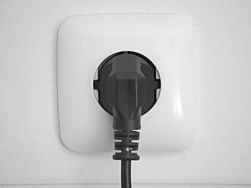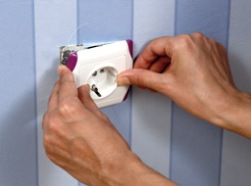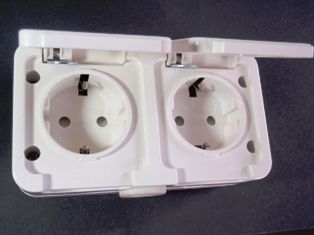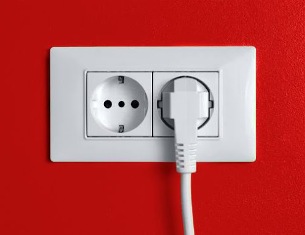Categories: Electrician at home, Sockets and switches
Number of views: 118784
Comments on the article: 14
How to choose a quality outlet
 We encounter electrical outlets every day, so it is very important that they are convenient and reliable. A lot depends on the correct choice of the outlet. Firstly, it is an opportunity to fully satisfy their needs in the inclusion of electrical household appliances. In addition, its service life depends on the correct choice of the socket.
We encounter electrical outlets every day, so it is very important that they are convenient and reliable. A lot depends on the correct choice of the outlet. Firstly, it is an opportunity to fully satisfy their needs in the inclusion of electrical household appliances. In addition, its service life depends on the correct choice of the socket.
When a person does not know the basic rules that must be followed when choosing an outlet, he often faces the problem of frequent failure of outlets. Perhaps, in this case, the outlet simply does not correspond to the actual load parameters of the household appliances that are included in it. Therefore, you need to know how to choose a quality outlet. We will talk about how to do this correctly in this article.
At the moment, the range of sockets is very large. In this case, your task is to choose a quality outlet. If you buy the first power outlet that was recommended by the seller of the store, you will make a mistake. Since it is highly likely that this outlet does not meet the required parameters.
What to consider when choosing outlets
 There are several criteria to consider when choosing a power outlet. Firstly, this is a type of electrical wiring. If your wiring is mounted directly in the wall, that is, of a hidden type, then you need to choose an internal outlet. A distinctive feature of this type of outlet is that it is installed in a special box that is pre-mounted on the wall. At the same time, only the socket housing is located outside the wall, and the body of the socket is located directly in the box.
There are several criteria to consider when choosing a power outlet. Firstly, this is a type of electrical wiring. If your wiring is mounted directly in the wall, that is, of a hidden type, then you need to choose an internal outlet. A distinctive feature of this type of outlet is that it is installed in a special box that is pre-mounted on the wall. At the same time, only the socket housing is located outside the wall, and the body of the socket is located directly in the box.
If your wiring is laid in an open way, then you need to purchase an external outlet. An outlet of this type is mounted directly on the wall. A distinctive feature of the external outlet is that its entire body is outside.
The next criterion is the degree of protection of the socket housing. In accordance with generally accepted standards, there are several types of sockets, which are classified depending on the degree of protection of their casing from the negative effects of moisture and mechanical impact of foreign objects. How in this case to choose a socket?
Explanation of the designation of the degree of protection of electrical equipment from environmental influences
As a rule, a special marking of the IP AB type is applied to the socket body, where “A” and “B” are digital values that correspond to one degree or another of the degree of protection of the case from negative influences. In order to make the right choice of sockets, you need to know the decryption of the data of numerical values.
So, the number "A" shows the diameter of the object, from the external influence of which the housing of the electrical equipment, in particular the plug socket, is protected. The number "B" indicates the degree of protection of this housing from moisture. We list the possible numerical values and the corresponding parameter.
The number "A" - diameter and type of item:
“1” - more than 50 mm, as well as the back of the hand;
"2" - more than 12 mm, as well as fingers;
“3” - more than 2.5 mm, including hand tools;
“4” - more than 1 mm, including nuts, washers, bolts and individual conductors;
"5" - the case is protected from dust, and is also completely protected from the effects of objects;
“6” - the case is completely dustproof and is fully protected from the effects of objects.
"0" - there is no protection of the case from the effects of objects.
The number "B" - the degree of exposure to moisture on the body:
“1” - individual drops that fall vertically on the body;
"2" - individual drops that fall onto the body vertically at a slight angle, up to 15 degrees;
"3" - rain;
"4" - spray of water that may fall on the housing at different angles;
"5" - a stream of water;
“0” - there is no protection against moisture.
For instance, IP 20 degree of protection will be sufficient in an ordinary apartment room,in the bathroom, select a socket with a degree of protection IP 44. For a link, see more about sockets in the bathroom.

Socket with degree of protection IP44
Other important criteria to consider
An important criterion for choosing a socket is the presence or absence of a grounding conductor in the wiring of the apartment (house). If one is present, then it is necessary to choose a socket with an additional grounding contact.
The next, no less important criterion for choosing the outlet is the operating nominal characteristics: type of current, its magnitude, voltage value, frequency of the supply network. The voltage of the household electric network is variable, its value is 220 volts, the frequency is 50 Hz. The rated current is selected in accordance with the load of household appliances that you plan to include in this outlet.
The correct life of the outlet depends on the correct choice of the outlet for the nominal parameters. If, when choosing an outlet, you find that there is no marking on it, then refuse to purchase it. There is a high probability that this outlet does not match the expected load or the parameter of the household network.
In addition to the above, one more criterion for choosing a socket is the quality of the plug connectors. Choose a socket in which the connectors with springs, as they provide additional rigidity of contact when you turn on the plug of the household appliance. If you choose a socket with conventional connectors, that is, without additional springs, then after some time, the contact stiffness between the connectors and the plug will decrease significantly, which will lead to their heating and possible damage.
In order to choose a high-quality outlet, pay attention to how the wiring of the electrical wiring to the outlet occurs. In this case, the best option is to choose the connection where the area of the contact surface of the wire with the contacts of the outlet is larger.
If there is a need to connect several outlets with a loop, then pay attention to the presence of an additional pair of contacts on the outlet. This will greatly simplify the connection of the wire, as well as increase the reliability of the connection.

Manufacturers of quality sockets
Expensive quality sockets are produced by European manufacturers. These are such well-known companies as "Legrand"," Schneider Electric ","Polo", "ABB", "Jung" and others. There are also very expensive designer sockets, most often these are Italian manufacturers, for example, "Bticino", "Fontini".
Sockets of Turkish and Polish firms "Makel", "Viko", "Karlik", "OSPEL" are distinguished by good quality and average prices. Cheap and very cheap sockets (a legacy of Soviet times and domestic analogues of well-known manufacturers) are better not to buy. Since among these outlets there are a large number of substandard ones. Although normal sockets can get caught, but this is a lottery.
Electrical outlets can be fake and original. Buy only original outlets, and do it in trusted places, where sellers value their reputation.
See also at i.electricianexp.com
:
